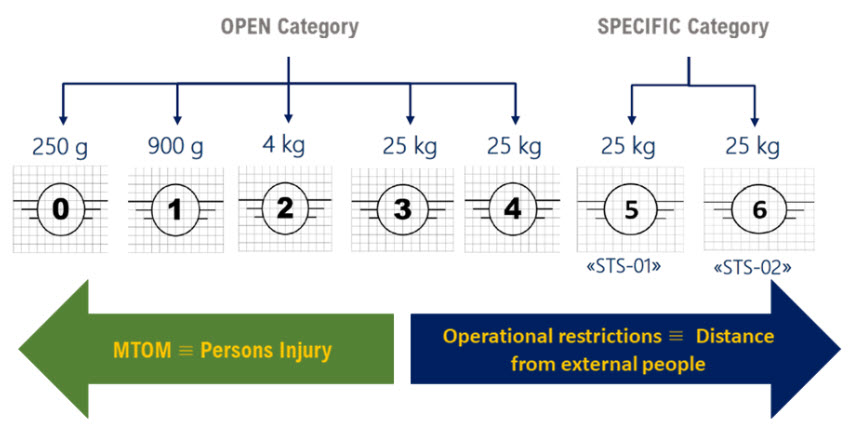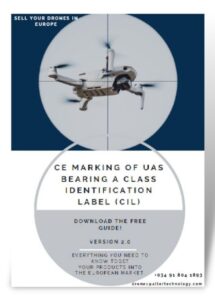Drone Testing and Certification
In 2022, ALTER obtained ENAC accreditation to provide conformity according to the European rules for drones intended to be operated in the open category and remote identification add-ons. Thus, we optimize our drone testing and certification service.
By obtaining this accreditation, ALTER becomes the first Notified Body in Europe for Regulation 2019/945. This achievement results from a long effort that has required the development of advanced flight test systems, test methods, and process innovation. The requirements aim to ensure the safety of drones placed on the European market.
Drone testing: A complete campaign for unmanned and remotely piloted aircraft systems (UAS/RPAS/drones)
Manufacturers play a crucial role in ensuring that products placed on the extended single market of the European Economic Area (EEA) are safe. They are responsible for checking that their products meet EU safety, health, and environmental protection requirements.
Safety testing
Environmental testing
Cybersecurity testing
Electromagnetic Compatibility (EMC) testing
Radio Equipment Directive (RED) testing
Mechanical: Vibration & shock, Impact
Climatic: temperature & humidity (dry heat, damp heat, thermal shock)
Salt mist test
Water and dust tightness test
Drone Certification to get your product into the EU market
Commission Implementing Regulation (EU) 2019/947: It was published on May 24, 2019, and establishes detailed provisions for the use of RPAS/UAS, as well as for personnel, including remote pilots and organizations that participate in such operations.
Since the Delegated Regulation 2019/945 on March 12, 2019, the Regulatory Framework for drones has changed rapidly since then. The European Union extends its competencies to regulate all Unmanned Aircraft Systems (UAS), resulting of a new regulatory framework. From that point, we have witnessed a quick evolution of this normative framework.
Then, we are going to mention the key points of all the documents that EASA has published since then to know the requirements that UAS must comply with to be marketed within the European Union Member States, as well as the means of compliance and guidelines related to pilot licenses and corresponding training centers.
It is important to note that this regulation does not make a distinction between professional and recreational users, so it is also mandatory for UAS users who carry out sports, recreational, competition, and exhibition activities, as well as all kinds of recreational activities in general, to comply with this regulation.
CE Marking and Class Label for drones
CE marking is the process by which the manufacturer/importer informs users and competent authorities that the marketed equipment complies with the mandatory legislation on essential requirements, in this case, Regulation 2019/945.
CE marking shall be visibly, legibly, and indelibly affixed to the product or the data plate affixed to it. When this is not possible or is not justified due to the size of the product, it will be placed in the packaging.
The UAS class identification label shall be affixed to the vehicle and its packaging in a visible, legible, and indelible manner and shall be at least 5 mm high. It shall be prohibited to place markings, signs or inscriptions on a product that may lead to confusion to third parties as to the meaning or form of the class identification label.
The indication of the sound power level contemplated in Part 13 to 15 of the Annex of the Regulation (page 300 of EASA eRules), will be placed, if applicable, in a visible, legible, and indelible way on the UAS, except when it is not possible or is not justified due to the size of the product, as well as in the packaging.
Importantly, highlight that up to 7 different classes of UAS have been established. Five of them, for the open category (C0 to C4) and two more for the specific category (C5 and C6) associated with two standard scenarios developed by the European Commission to facilitate the application for permits and the corresponding security analysis: STS-01 and STS-02, respectively, of the specific category.
The specifications and physical characteristics of each unmanned aircraft will define the class to which they belong.

Drone Testing and Certification: a complete service offering to get your drone in the EU market
As ALTER, we are proud to have experts in the drone sector who have developed the necessary procedures to show compliance with the new regulatory framework in terms of drone testing and certification. They will be able to guide manufacturers or importers in the certification process of their drone system to introduce their product into the European market.
DRONE CERTIFICATION SERVICE ensures and guarantees a proper alignment of the test campaigns and verification methods proposed by ALTER to the Drones’ Community in order to provide a reliable service.
We focus our service on three main areas:
Learn more in our CE Marking guide!
Find out everything you need to know to get your drones into the market in our guide: “CE marking of UAS bearing a class identification label (CIL)”. You will get a comprehensive overview of the CE marking and class label requirements.

